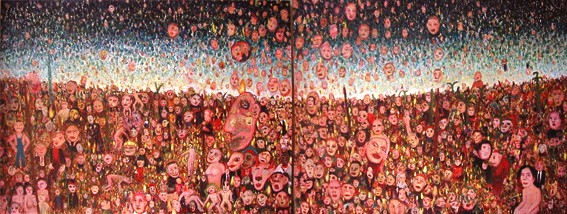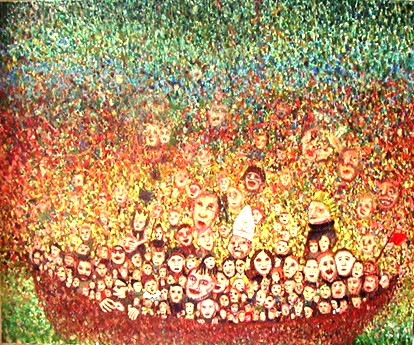Reviewer,
essayist, poet and polyglot, Maya Khankhoje has published in many
journals including South Asian Women's Forum, Urban Mozaik,
Canadian Theater Review, Sumach Press, and Indolink.
She is presently the Assistant Editor at Montreal
Serai.
*
* * * * * * * * *
 Eric
Carlos Bertrand is a multidisciplinary artist. He has participated
in one-man shows and collective exhibitions in Mexico, Canada,
Finland, Slovakia, Lithuania and the United States. The artist
is currently working on his doctoral dissertation at the Université
de Québec, an anthology of Cuban critic and theoretician
Gerardo Mosquera as well as preparing several one-man shows which
will be held in Mexico and Canada.
Eric
Carlos Bertrand is a multidisciplinary artist. He has participated
in one-man shows and collective exhibitions in Mexico, Canada,
Finland, Slovakia, Lithuania and the United States. The artist
is currently working on his doctoral dissertation at the Université
de Québec, an anthology of Cuban critic and theoretician
Gerardo Mosquera as well as preparing several one-man shows which
will be held in Mexico and Canada.
Anyone who enters Espacio México,
an art gallery run by the Mexican Consulate in Montreal, knows
what to expect: a glimpse into the soul of Mexican art which is
as broad and varied as the landscape of the country, as ancient
and contemporary as its history and as tormented and deep as a
people who sing to death rather than bewail it. In other words,
anyone who ventures into this space can expect the unexpected.

When I ventured into Eric Carlos
Bertrand's space to view his exhibition titled Utopologies and
Grotesques I was thrown into a whole universe ranging from tiny
dots on tiny canvases to huge blobs of paint on huge canvases.

Each set of dots grew like an
embryo until it became a living organism, then groups of organisms
and finally a multitude. I did a quick walkabout following the
series of canvases on the walls and then returned to view the
paintings calmly once the crowds had cleared. But my experience
was not a calm one, because the paintings assaulted my senses
and stirred my emotions. And then I had an epiphany. It struck
me that Bertrand's work was a coherent manifestation of the grotesque,
associated with artists like Durer and

Goya, writers like Rabelais, the
Grimm Brothers and Becket and cinema giants like Fellini or Polanski.
The artist resorted to impressionist and post-impressionist techniques,
such as pointillism and atmospheric perspective, to create his
Utopologies, a word he coined from Utopia and topology, that branch
of mathematics that deals with the concept of continuity.

When asked about the influences
that have informed his work, Bertrand named Bosco and Seurat,
but acknowledged that Ensor was his greatest inspiration. He was
keen to explain that whereas his art is contemporary, he has not
broken links with the past. He firmly believes that innovation
within tradition is possible without rejecting the past, which
is what has happened in many developed countries. If pushed to
define his art, he would place himself within the Latin American
current, or in any case, within a current which belongs to the
margins rather than to the center.
I can only hope that Bertrand
finishes his dissertation as quickly as possible so he can return
to painting dots on canvases and letting them brew and proliferate.